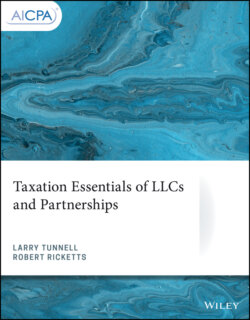Читать книгу Taxation Essentials of LLCs and Partnerships - Larry Tunnell - Страница 42
Notes
Оглавление1 1 In many states, only a limited shield of liability protection is available to partners in LLPs. That is, liability protection is available only against losses attributable to acts committed by other partners. In these states, LLP partners retain full, unlimited personal liability for acts of the partnership (for example, defective performance) or acts of non- partner employees of the partnership. This is a primary reason for the popularity of LLCs, which generally carry a full liability shield for owners against liability for acts committed by others, whether or not they have equity stakes in the company.
2 2 Alabama, Alaska, Arizona, Arkansas, Colorado, Delaware, District of Columbia, Florida, Georgia, Hawaii, Idaho, Illinois, Iowa, Kansas, Kentucky, Maine, Maryland, Minnesota, Missouri, Montana, Nevada, New Mexico, North Carolina, North Dakota, Ohio, Oklahoma, Pennsylvania, Rhode Island, South Dakota, Tennessee, Texas, Virginia, Washington, Wyoming, and the U.S. Virgin Islands allow firms to organize in the LLLP form. Although LLLPs cannot be formed in California, those formed in other states are recognized in California.
3 3 A single-owner LLC will not be taxed as a partnership. It is a disregarded entity and will instead be treated as a sole proprietorship, or if owned by a corporation, as a division of the corporation. However, the legal protection afforded to members of an LLC will be available to a single-owner LLC as well, allowing the sole proprietor to receive limited liability protection similar to that of a corporate shareholder without paying corporate income tax.
4 4 An LLC is taxed as a partnership at the federal level unless an election is made to be taxed as a corporation. How the entity is taxed at the state level will depend upon the state(s) in which it is operating.
5 5 By law, an S corporation can have only one class of stock and each share of that stock must have an equal interest to all the other shares in every item of S corporation income, loss, credit, and the like. Section 1361(b)(1)(D).
6 6 The regulations actually identified six corporate characteristics: two or more associates, profit motive, free transferability of interests, limited liability, unlimited life, and centralized management. However, the regulations noted that the first two of these characteristics (associates and profit motive) were common to both partnerships and corporations, and so based the classification criteria on the remaining four characteristics. If the entity possessed more than two of these four remaining characteristics, it was classified as a corporation for federal income tax purposes.
7 7 Note that certain publicly traded partnerships are classified as corporations for federal income tax purposes, regardless of their preference under the check-the-box rules. A publicly traded partnership is one which conducts an active trade or business and the shares of which are traded on an established securities market or a secondary market. See IRC Section 7704 of the Internal Revenue Code and the Treasury Regulations thereunder.
8 8 In some cases, an entity which technically constitutes a partnership may desire not to be recognized as such for federal income tax purposes. Reg. Sec. 1.761-2 provides that such entities can elect not to be taxed as partnerships (and therefore avoid having to file a partnership tax return) if they are formed for investment purposes (rather than to conduct joint business activities) or for the joint production, extraction or use of property, but for the purposes of selling services or property produced or extracted.
9 9 See Reg. Sec. 301.7701-3(g).
10 10 One important exception will apply where one or more partners have a deficit balance in their capital accounts as of the date of the deemed liquidation of the partnership. Partners with deficit capital balances will be required to make contributions to the partnership to restore their capital balances to $0. Forgiveness of this obligation by the entity will likely result in cancellation of debt income to such partners.
11 11 See IRC Sections 311(b) and 331.
12 12 Many partnerships also maintain a set of GAAP books and records, which may differ from the “book” records required under Section 704(b).
13 13 Note, however, that if the shareholder does not withdraw a reasonable salary as compensation for any services rendered on behalf of the S corporation, some or all of his or her pass-through income may be reclassified as wages or salary income.
14 14 Section 1402(a)(13).
15 15 Proposed Reg. Sec. 1.1402(a)-2(h)(2), issued January 13, 1997, and not yet replaced by permanent regulations as of the date of this publication.
16 16 Proposed Reg. Sec. 1.1402(a)-2(h)(5) and (6)(iii), issued January 13, 1997, and not yet replaced by permanent regulations as of the date of this publication.
17 17 Proposed Reg. Sec. 1.1402(a)-2(h)(4), issued January 13, 1997, and not yet replaced by permanent regulations as of the date of this publication.
18 18 Proposed Reg. Sec. 1.1402(a)-2(i) Example (i), issued January 13, 1997, and not yet replaced by permanent regulations as of the date of this publication.
19 19 Proposed Reg. Sec. 1.469-5(e)(3)(i)(B).
